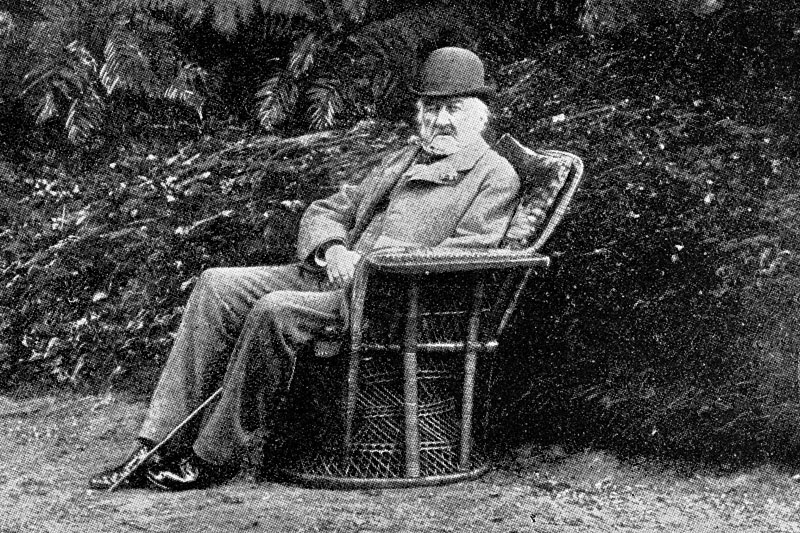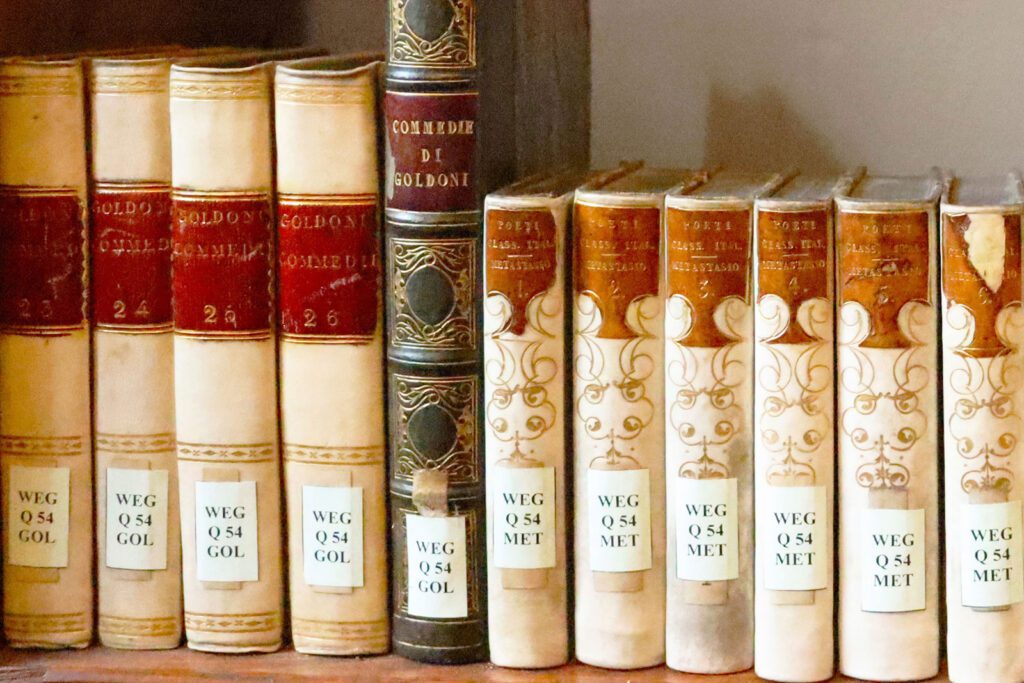Our original distinctive collection.
History of the Collection
The core collection around which the library has grown is the original library of our founder, William Ewart Gladstone (1809-1898). Known today as the Gladstone Foundation Collection, it contains approximately 11,000 titles in over 28,000 volumes.
From an early age, William Gladstone was a prolific reader and scholar. We have copies in our collections of some of the earliest books he owned and read. His Eton schoolbooks, such as his 1823 copy of the Iliad (London, 1823, P 32/19) also contain early examples of Gladstone’s marginalia, the practice of writing by hand in and around what he was reading. There are approximately 6,000 instances of marginal marks throughout his collection. As Gladstone scholar John Powell has remarked, the annotated volumes provide ‘an unparalleled access to Gladstone’s inner life’, allowing anyone to sense ‘the instinctive personality, before the weight of observation, reflection, duty, and calculation began to impinge’ (John Powell, “Small Marks and Instinctual Responses: A Study in the Uses of Gladstone’s Marginalia.” Nineteenth-Century Prose, 19 (1992), 17.)
Reading, owning, and annotating books and other, more ephemeral print items such as religious tracts and pamphlets became a life-long habit. As Ruth Clayton-Windscheffel has written in her major study of Gladstone and his relationship with books, Reading Gladstone (Basingstoke: Palgrave Macmillan, 2008):

‘Gladstone the reader was in many ways an extraordinary figure; an individual for whom book-reading formed not only the bedrock of his understanding of his own identity, merit, and mission, but also constituted the key delimiter of his daily life.’ (p. 234).
By the 1890s, Gladstone’s thoughts turned towards the fate of his vast collection after his death. He decided to establish a library here in the village of Hawarden where he had lived since the 1840s. So the story goes, Gladstone is said to have carried his books from Hawarden Castle to the temporary library he constructed, the ‘Tin Tabernacle’, in a series of wheelbarrow trips, aided by a valet and his daughter, Mary Gladstone (later Mary Drew). After its formal foundation as St. Deiniol’s Library in 1895, Gladstone continued to donate and acquire titles specifically for the new library.
After his death on 19th May (Ascension Day) 1898, a further significant collection of books, tracts, and pamphlets were given by bequest to St. Deiniol’s Library in the early 1900s, and then sporadically by the Gladstone family up to the early 1930s. Until quite recently, his books were dispersed throughout the collections, shelved by subject.
Within the last 20 years there has been increasing scholarly interest in Gladstone’s reading life. An AHRC-funded project to catalogue his collection and transcribe his annotations was completed between 2006 and 2009 in collaboration with the University of Liverpool. This can be accessed online as GladCAT.
In 2013, Gladstone’s collection of books were gathered together for the first time since the 1890s in the History Room, the second of our two main reading rooms. Re-christened the Gladstone Foundation Collection, anyone visiting or reading in the library can see at a glance the breadth and depth of Gladstone’s reading life.
Description of Contents
Titles owned, read, and annotated by W.E. Gladstone
The Gladstone Foundation Collection is arranged into 21 subject areas. It is also in six languages – Latin, Greek, English, French, German, and Italian. It is organised using a classification system devised by Gladstone himself.
The collection is arranged into the following alphabetical subject areas:
- A – Biblical Archaeology
- B – The Bible
- C – Patristics (Church Fathers)
- D – Philosophy
- E – Theology
- F – Christian Practice
- G – Christian Liturgy
- I – Church History
- K – Anthropology (inc. anthropology of religion and non-western religions)
- L – Classical History
- M – History
- N – Law
- O – Languages and Philology
- P – Classical Literature
- Q – European Literature
- R – English Literature
- S – Bibliography
- T – Natural Sciences
- U – Political Economy and Education
- V – Decorative and Visual Arts
- W – Travel and Topography
Gladstone was also a voracious reader of tracts, pamphlets, and periodicals. Many of these titles are currently held in our general pamphlets and periodicals collection in the Annex, and are classified following the same principle as the general collection (e.g. a pamphlet with class-mark 66/A/8 would be the 8th item in box ‘A’ of subject 66, ‘Middle East’).
Two bound collections, the Gladstone Tracts (class-mark ‘G.T.’) and the Hawarden Castle Collection (class-mark ‘H.C.C.’) are shelved alongside the Foundation Collection in the History Room gallery.
The library also holds microfilm copies of over 6,000 tracts and pamphlets that form the Gladstone Pamphlets collection housed at the National Library of Wales. Many items in this collection contain titles with Gladstone annotations. (See below for information on accessing these collections.)
Items by or about W.E. Gladstone
The library also contains an internationally significant collection of almost 300 titles by and about W.E. Gladstone. These are also housed in the History Room alongside the Gladstone Foundation Collection (class-mark ‘M 34.9 G’).
Our holdings include a unique 12-volume set of ‘speeches and writings’, gathered together in 1921 (Vol. 12 is an index). This contains 238 public addresses, pamphlets, book reviews, and periodical articles. While not exhaustive it is one of the most complete single collections of these materials in the country.
We also have a pre-publication ‘proof’ copy of his major three-volume work, Studies on Homer and the Homeric Age (3v. Oxford: Oxford University Press, 1858, M 34.9 G/25), with extensive annotations and corrections throughout by Gladstone.
Additionally, the library holds a 38-volume collection of newspaper clippings containing appearances and speeches made by Gladstone through much of his life and career gathered by his friend Sir Robert Phillimore (1810 – 1885). (M 34.9 G/2).
Finding Aids
If you are looking for books, tracts, and pamphlets owned and read by W.E. Gladstone, including information on annotated items, head to GladCAT.
This contains transcriptions of all of Gladstone’s marginalia (except tracts and pamphlets).
To make the most of GladCAT, including how to search the catalogue, please see the following guide here.
(N.B. Titles with the class-mark ‘G.T. M/F’ are microfilm titles; please see below for guidance on accessing these.)
If you are looking for works by or about W.E. Gladstone, MainCAT should be where you go first. The majority of these items have the class-mark ‘M 34.9 G’ – search for this term (including quotation marks) in the search bar here.
Three typescript bibliographies of materials relating to Gladstone were produced by the library (under its former institutional name of St. Deiniol’s Library) in the 1980s and 1990s:
- A Bibliography of Gladstone Publications at Saint Deiniol’s Library, compiled by Patricia M. Long, with introduction by H.C.G. Matthew, 1976-77.
- Gladstoniana: A Bibliography of Material relating to W.E. Gladstone at St. Deiniol’s Library, compiled by Caroline J. Dobson, with introduction by H.C.G. Matthew, 1980-81.
- Gladstone: A Bibliography of Material Held at St. Deiniol’s Library, compiled by Lucy M. Adcock, 1997-98.
These titles are part of a larger collection of typescript bibliographies on the collections produced from the 1970s to the 1990s. Copies of these can be made available for consultation in person. Digital copies of these will be made available here soon.
An excellent starting point remains The Gladstone Diaries, edited by M.R.D. Foot and H.C.G. Matthew (14 vols. Oxford: Clarendon Press, 1968 – 1994). These contain annotated transcriptions of the original manuscript diaries held at Lambeth Palace Library. Volume XIV contains not only an index to the complete diaries, but also a bibliography of all titles recorded as read by Gladstone in the diaries, alongside a ‘dramatis personae’ of all individuals named in the entries. (A cross reference to diary entries for most titles read by Gladstone is included in catalogue records on GladCAT).
Other useful reference titles relating to Gladstone studies include:
- Bassett, Arthur Tilney. Gladstone’s Speeches: Descriptive Index and Bibliography, with a preface by Viscount Bryce (London: Methuen & Co, 1916). M 34.9 G/3.
- Keith-Lucas, Bryan, compiler. The Gladstone-Glynne Collection: a catalogue of the oil paintings, water-colours, sculptures and miniatures and a supplementary list of prints and drawings at Hawarden Castle; compiled… under the direction of the Lord Gladstone of Hawarden (Hawarden: Privately Printed for Hawarden Castle, 1934). M 34.9 G/6.
Further Information
The Gladstone Foundation Collection, and the majority of items by and about Gladstone, are shelved in the History Room, the second of our two main Reading Rooms.
Unbound tracts and pamphlets owned and read by Gladstone are currently (Autumn/Winter 2019) housed within our general pamphlet collection. This is housed in the Annex.
Large printed items (i.e. folio-size, or anything 30cm or over in height) are shelved in the Annex. These are listed on both GladCAT and MainCAT under the location ‘Annex Oversize’. Please ask for assistance from a member of library staff if you would like to look at an item from this collection.
A number of items in the Gladstone Foundation Collection are also held in the Strong Room, one of our restricted access areas. Any such titles are listed on MainCAT under the location ‘Muniments Room’. These items can be viewed by request only between Monday to Friday, 9.30am to 4.30pm. To request an item in the Muniments Room, please complete the Request to View Archives and Special Collections form at least 14 day’s prior to your intended visit.
Any items with the class-mark G.T. M/F are part of the ‘Gladstone Tracts on Microfilm’ collection. To access these, please fill in the details of the item you would like to consult on a Request to Read Restricted Items’ form via the link above, and return the form to the library as soon as possible before your visit either in person or via email. Please include the ‘item number’ given in the ‘notes’ section of the catalogue record – this makes it easier to find items on the microfilm reels.
If you are not staying with us as a resident, you can become a Reader to use and consult any of our collections, including the Gladstone Foundation Collection. For information on becoming a Reader, follow the link here.
You can check availability for accommodation here.
For any enquiries relating to the Gladstone Foundation Collection, or any of our collections, get in touch via email [email protected] and we will be happy to answer any queries or questions.
